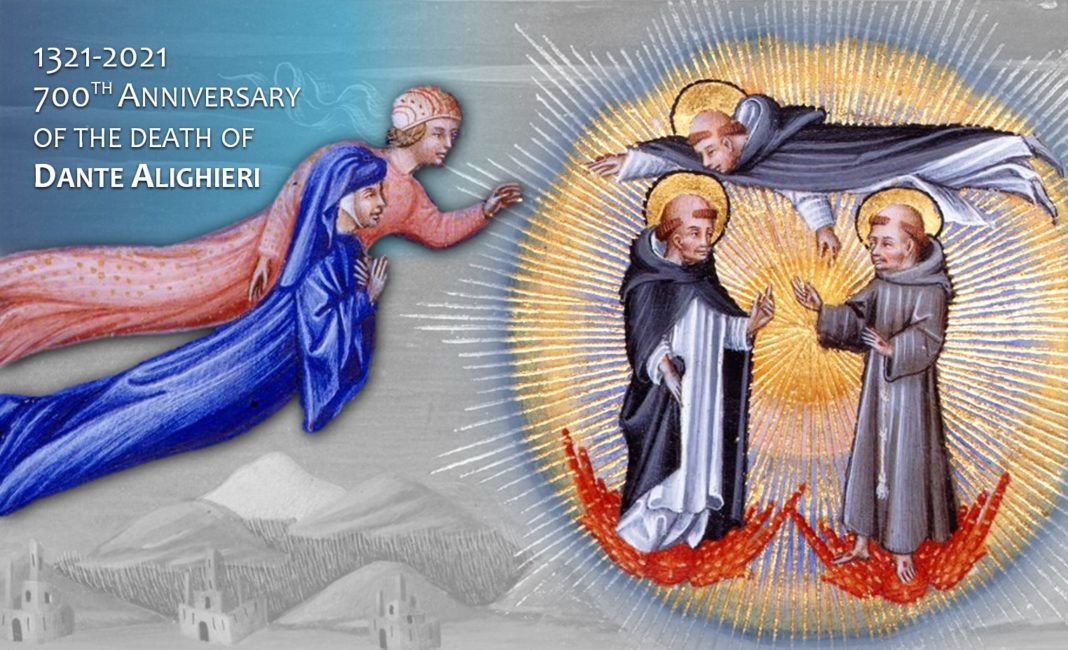Little or nothing is known of Dante’s relationship with the Franciscans during his life. Dante was born in Florence in 1265 and died in Ravenna during the night of September 13-14, 1321. He surely had contact with the Minorite community of his native city of Florence where he attended the studium of Santa Croce. At that time, the Franciscan Peter John Olivi (1248 ca-1298) was serving as a lector there. Friar Peter, from France, was a preacher, a theologian, and a defender of the rigorist persuasion within the Order. He is considered one of the founders of the Franciscan movement of the Spirituals.

When Dante purportedly stayed in Bologna from the summer of 1286 to the summer of 1287, he certainly had an opportunity to enter that city’s Basilica of San Francesco. It was the first church dedicated to the Poverello after the one in Assisi. Moreover, when Dante moved from Verona to Ravenna in 1318, we can confidently assume he was among the friars when he frequented that city’s Neonian Basilica of San Pietro Maggiore. A few years earlier, in 1261, Archbishop Filippo Fontana had handed the basilica over to the Franciscans, along with its houses, cemetery and vegetable gardens. Dante was the guest of Ravenna’s ruling Da Polenta family, whose private chapel was inside the basilica. Some years earlier, the friars had rededicated the basilica to St. Francis of Assisi. It was therefore no coincidence that Dante’s funeral was celebrated in that basilica and that his body was buried in the adjacent cemetery.
Dante’s familiarity with the Franciscan Order allowed him to get to know and love St. Francis to the point that he dedicated an entire canto to him. Francis is the only character in the Divine Comedy to be thus honored. However, Dante’s Francis is not limited to canto XI of Paradiso. One must consider the influence of St Francis’ Our Father, which is paraphrased in canto XI of Purgatorio. There, “the passage that refers directly to the Minorite milieu is immediately evident. It is clearly seen in the sanctificetur nomen tuum, which Dante renders as, ‘Praised be Your name and Your omnipotence / by every creature.’”[1]
To be fair, however, one should remember that while St. Francis and his conformity to Christ are exalted in canto XI of Paradiso, the next canto features the Franciscan St. Bonaventure who is called upon to sing the praises of St. Dominic, but Dante also has him deliver a forceful and bitter reproach for various deviations among the Franciscans. These include the polemics between the Spirituals and the Conventuals, the lacerations of the Order, the rebellion of some friars against the established authorities, and the loss of the humility that once typified the early Minorites[2].
“Therefore, the topic of Dante and the Franciscans cannot be presented solely in tones of triumphalism. Indeed, in some cases one could quote the verse that Vanni Fucci addressed to Dante: ‘And I have told you this to make you grieve’! (Inferno XXIV 151). The Franciscan world does not appear as an appendix in the Divine Comedy, but—according to some —actually constitutes its substance, intertwined as it were with the events of Christianity. The Church and Franciscanism are two reflecting, concentric circles, or to use Dante’s image, ‘twin rainbows, parallel in shape and color,… the outer one born of the inner’ (Paradiso XII 10 and 13, regarding the two garlands of the Blessed in the sky of the Sun, that of St. Thomas and St. Bonaventure, each consisting of twelve ‘suns’).”[3]
Still, on the relationship between Dante and the Franciscan family, one should point out canto XVI, verse 106 of the Inferno, in which the Dante actor says, “I had a cord around my waist.” Anna Maria Chiavacci Leonardi explains, “The cord that was used to ensnare the leopard and Geryon is a symbol that remains undeciphered.”[4] She continues: “That Dante literally had a rope around himself, as Buti wrote and today Vallone sustains, was not by chance. Rather, it was in Dante’s capacity as a Franciscan tertiary. In fact, the Franciscans were called ‘corded friars,’ as noted in Inferno XXVII 67. This fact is not documented in any way, but there is other later testimony about it.”[5]

[1] Matthias Buergel, La parafrasi dantesca del Paternoster come espressione di spiritualità francescana (available for download here at www.academia.edu)
[2] Pompeo Giannantonio, Dante, S. Francesco e la tradizione francescana, in Dante e il francescanesimo, Cava dei Tirreni, Avagliano, 1987, pp. 209-228, specifically p. 223.
[3] Alberto Casalboni, Dante e i francescani, in “Collectanea franciscana” 70, 2000, 3-4, pp. 390-411, specifically p.392.
[4] Dante Alighieri, Commedia. 1. Inferno, con il commento di Anna Maria Chiavacci Leonardi, Milano, Arnaldo Mondadori, 1991, p. 501, explanatory note 106.
[5] Ibid. p. 506, explanatory note 106. Cf. Alberto Casalboni, work cited, 393-394.














